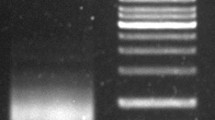Abstract
Centromere-specific histone H3 (CENH3) has been used to detect active centromeres, and to analyse the DNA sequences closely associated with the centromere, because they localize only in active centromeres and bind directly to the DNA. In maize and rice, the centromeric retrotransposons (CR) are shown to be closely associated with their own CENH3 whereas no such association was found in Arabidopsis thaliana. In this study, this sort of association was investigated in sugarcane. Two expressed sequence tag groups encoding putative sugarcane CENH3 (SoCENH3) were found in a sugarcane-expressed sequence tag database. Their deduced amino acid sequences were similar to these of the CENH3s in rice and maize. An antibody against rice CENH3 seemed to crossreact with the SoCENH3s, and stained sugarcane centromeres. A set of immunoprecipitation tests was conducted with the antibody and chromatin from the sugarcane genome to reveal CENH3-associated DNA sequences in sugarcane. Centromeric tandem repeats (SCEN) and centromeric retrotransposons of sugarcane (CRS) were significantly precipitated with the antibody, meaning these repeats are directly interacting with CENH3 in sugarcane centromeres.
Similar content being viewed by others
Author information
Authors and Affiliations
Corresponding author
Rights and permissions
About this article
Cite this article
Nagaki, K., Murata, M. Characterization of CENH3 and centromere-associated DNA sequences in sugarcane. Chromosome Res 13, 195–203 (2005). https://doi.org/10.1007/s10577-005-0847-2
Received:
Revised:
Accepted:
Issue Date:
DOI: https://doi.org/10.1007/s10577-005-0847-2




